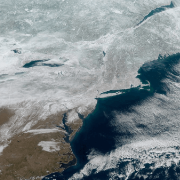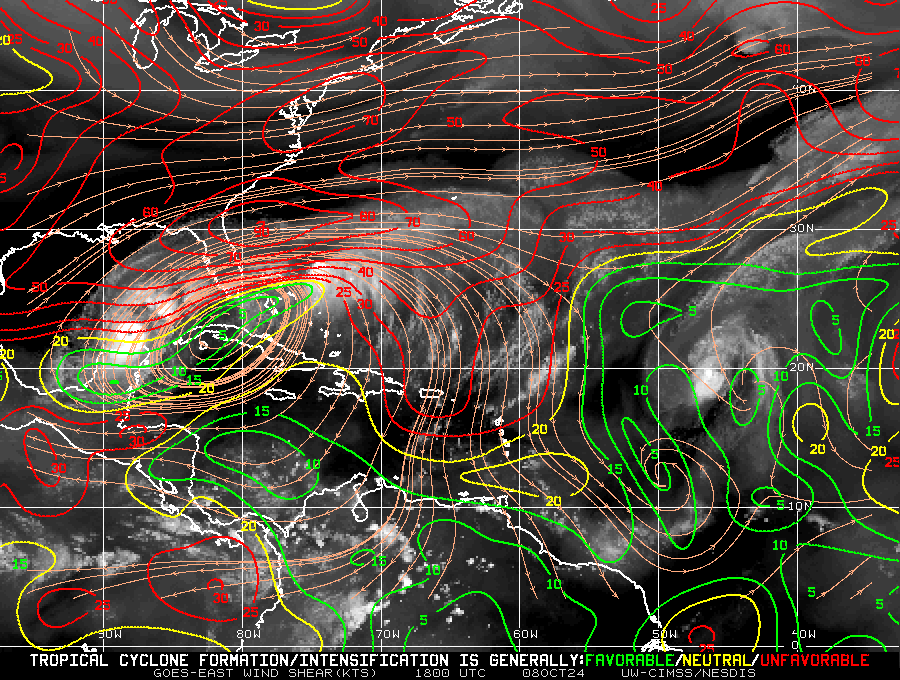
Moderately Unstable
Meteorologist-
Posts
324 -
Joined
-
Last visited
About Moderately Unstable

Profile Information
-
Four Letter Airport Code For Weather Obs (Such as KDCA)
KCOS
-
Location:
Colorado Springs, CO
Recent Profile Visitors
2,120 profile views
-
I buy what you're selling. It's tricky because the modeling suggests LL sfc circulation lagging a bit behind the radar returns close to landfall, and we also have the chance for a slight east tick. If the dynamics of the eye remain as they are now and you extrapolate fairly linearly... I'd take Holmes Beach/Cortez. It's certainly "in the ballpark" at this stage.
-
(1) Tornadoes: There is a baroclinic enhancement/processes going on that are raising the tornado potential leading to the notable apparent outbreak and intensity of cells. The elongated hodographs due to the RF quad of Milton are interacting with favorable jet dynamics and a warm frontal boundary. For all intents and purposes, areas of SE and central Florida may as well be in a warm sector. Also with the high pwatts/moisture, you can spin things up more easily. Overall hodographs are "meh+", but LL SRH values are extremely high - stp values supportive of EF-3 for many areas. HRRR fcst soundings and spc mesoanalysis show the various support features well. I'm still surprised by # of strong tornadoes. Violent tornadoes from hurricanes are a bit unusual. Spc did well with the 10% hatch. Certainly its own story after the storm is over. Not sure where this will fall in historical context. (2) In general, it has been progged for a few days that the storm will come in as a weakening C3. That continues to appear accurate. It is not "making a comeback" now...and it wasn't supposed to. It's more a question of "how well it holds together" in these final hours. It has hot bath water, and upper level support, but shear is clearly unfavorable. Eye may close off temporarily but should be more open than closed. Shear and closed eyewalls are not friends. Also remember that as this occurs, precip banding will continue to trend toward the vorticity (North), versus a direct alignment of the column. That's also contributing to the wobbles. Beam height right now of E eyewall from KTBW is 9k feet. I buy the VDMs more than the TB radar for eyewall characteristics since, you know, they're there. (3) As the mid level vort max moves north, it will and is tugging the storm north. Hard to prognosticate landfall watching radar frame by frame. Storm is interacting with sw trough. Long term motion still looks ne ...it's messy with the complex eyewall changes going on and the baroclinic interaction. I'm not on the early south landfall train right now. Still kinda seems Sarasota to Bradenton to me, but I'm leaning Sarasota.
-
I am seeing some minor shear effects, no dry air effects on recent IR scans. Shear vector is well enough aligned to storm motion and shear as analyzed is minor to moderate...but non-zero. At the moment the coldest convection is down shear of the the eye which means mass dumping in the eye is inferior to the strongest convection being dumped into the eye though still occurring. Clouds SW of the eye are a bit warmer than NE and have been watching that trend for a bit now. Certainly agree on lack of dry air issues. Meso vortices are visible on zoomed in high res sat imagery so the mixing of momentum and energy concentration in eyewall is fine. Does not appear to be RIing currently, seems like weak steady strengthening mixed with periods of steady state atm. Eye temp is warming, slowly. The Dvorak 910s to maybe 905 seem about right. In fairness to Milton...it is hard to RI when you're close to the mathematical maximum intensity for your environment. Curved bands look good. MMUN radar shows a generally closed eye with a couple open blips on a few frames, with the next outer band potentially showing opening to the north (this is where HH are key - beam height/attenuation/distance etc may preclude optimal viewing of the band opposite to eyewall as seen by MMUN radar). Together, I would bet on marginal strengthening to steady state atm but another impressive presentation in general. Hurricane hunters were 70 nm out from eye, at reporting time 22:42, traveling at 251 kts. 16 mins from the eye at that speed, so a nice close shave and a haircut. Do they make it!?! *Grabs popcorn*
-
Just a little bit of fun math. Currently the latest AF H hunter AC fix distance to the latest CIMISS ADT estimated center fix, is 455 nm. The WC-130J can fly at a maximum cruising speed of 360 kts, but will likely average closer to 300. The storm is moving NE, 9 knots at heading 52 degrees according to ADT, while most recent NHC motion is ENE. Integrating this together, assuming the ac has about 450 nm to fly, it's slightly under 1.5 hours ish from the first eye dropsonde (it took a few mins to compute this). This should put it there just before the 4PM CDT advisory. Edit at 19:55Z - they're currently getting a small tailwind and are cruising at 360 kts, which is as noted close to max cruise speed. They're also now down to about 320(ish) nm, which, combined, leads to about the same arrival time (before the 4PM advisory).
-
Well, a few thoughts. First, EWRCs are complicated and an active area of research. In fact, some of the data from past hurricane hunter flights has been used for it. Let's start with step one. This was a fairly classic EWRC. Very very strong, very small storm with extremely tight eye developing a classic distinct secondary closed outer energy maxima. But the step two is a bit more open. Does eyewall #2 "rob" eyewall #1, does eyewall #1 simply disintegrate due to energy starvation, does turbulent flow between the two eyewalls interact in a destructive manner? Overall, we saw pressure rise to about what would be expected, I think I mentioned 930 mb in chat yesterday actually. And we did see the outer wind radii expand. As you noted, it's a small storm. As of now it is still a small storm, and yes that did likely play a role. Going from 4 nm to 16 is different to, say, 10 nm to 45. We also know EWRCs can take on different forms, as you note. This was not a merger though. We did have two distinct eyes, radar returns and IR showed eye one weakened with warming cloud tops as eye 2 closed and strengthened with symmetric lightning around that convection last night (which suggests it had relatively strong updraft rates throughout - sufficient for a good amount of charge separation that we don't see as much of in steady state hurricane environments). EWRCs can be favorable or unfavorable. Unfavorable occur with relatively larger moisture gradients or dry air intrusions and/or increases in wind shear. Given the higher shear status early today, but lack of dry air intrusion, the EWRC here seemed fairly neutral - as shear relaxes, it will likely restrengthen as it appears to be doing now with clearing of the new eye. This is the extent of my knowledge on the topic, others can chime in with more if they have additional insight. Did this answer your question relatively?
-
It is not. Here are the facts. The more the public focuses on a line, the less they care about not being on it. Also, the NHC is not omnipotent. There are track errors. Part of their widespread success and public trust is because they de-emphasize exact paths, tell you where it's approximately going to be, paint a wide swath, and to get out of dodge. This storm is several hundred miles away. It is not physically possible to forecast whether it will go right over the bay, north, or south right now. We can try. There are trends. But anyone who tells you they know the precise coordinates - no, they don't. For Milton, the main memo is: powerful hurricane may kill you and your loved ones if you don't evacuate. The reality is, the storm could be shredded by shear, and weaker than forecast at landfall. Or, shear could affect it less than expected and it's stronger (etc). They certainly have their best guess of the eye location and track, and that type of info is communicated to EM and gov where it isn't as likely to be distorted. It's still available on the public products as you see - it just isn't the emphasis. This is not calling you out. Most of the chat is about individual run updates. I'm mainly trying to explain why nhc doesn't go out of their way to focus on the eye's track in their public products. Private mets that do contract work for commodities get paid to do what you're asking for.
-
523 URNT12 KNHC 080119 VORTEX DATA MESSAGE AL142024 A. 08/01:00:30Z B. 21.81 deg N 090.28 deg W C. 700 mb 2319 m D. 912 mb E. 050 deg 13 kt F. CLOSED G. CO4-24 H. 135 kt I. 345 deg 2 nm 00:59:30Z J. 093 deg 128 kt K. 028 deg 6 nm 00:58:30Z L. 166 kt M. 264 deg 3 nm 01:02:00Z N. 356 deg 158 kt O. 264 deg 3 nm 01:02:00Z P. 13 C / 3062 m Q. 22 C / 2996 m R. 15 C / NA S. 12345 / 7 T. 0.02 / 1 nm U. AF302 1114A MILTON OB 12 MAX FL WIND 158 KT 264 / 3 NM 01:02:00Z OUTER EYEWALL OPEN SW ;
-
Yes. You can see on the goes 16 meso 2 minute floater imagery right now the ring of concentric cloud tops colder than -80 C. That correlates to a broad zone of long and deep positive cape soundings (talking theory here). ERCs can be triggered by a couple different things - so they aren't a universal sign of health. But they do typically signify that a storm has reached maximum potential intensity for the given environment. If you have more heat energy available than the eyewall can convert into kinetic energy, you get a second eyewall. That can happen both in a great environment like this one, and a worsening environment where the storm can no longer support the intensity of the eyewall it has, from what I've observed. Physically, when an EWRC occurs, the pressure wind relationship shifts. The kinematic and thermodynamic energy of the inner eyewall is trapped by the outer eyewall. As subsidence increases in the inner eyewall, wind speed is transferred to the outer eyewall as it contracts, with pressure rising. Thus, temporarily, we get a stronger wind speed than pressure would portend. As convection in the old eyewall ceases and the column disintegrates, the outer eyewall becomes dominant and then can mix freely and the relationship flattens again. So, in the context of a record-nearing storm, it isn't a sign of "bad health". It's simply physics. Storm can't get stronger with the eye it has, so it's going out to get a new ring.
-
Bummer indeed. But considering we did still get an official measure of 897 mb (pending post season re anal)... it's missing for posterity but, sub 900 is unusual. Milton is only surpassed now by Rita, for intensity in GOM. That's it. It is #2. If it goes to 930 and drops down again to 920 mb tomorrow it'd still be a c5. It's physically quite difficult to get this type of pressure. Today was a show, and it's unfortunate that it portends an unfortunate Floridian reality. It does seem likely to see re- strengthening after an EWRC with the favorable short term environment. What is going to be interesting is watching the overall angular momentum change there. Again, if we conserve energy and broaden the wind field, and we then begin to decrease pressure again and contract the new eye, the overall fetch of the storm should increase. // Worked with Tomer years ago. Smart dude. Really happy he's done so well.
-
Few bites from dropsonde(s) (ne eyewall and eye). (1) They dropped in ne eyewall, and the sonde rotated halfway around the eye. (2) Still dumping mass at the upper levels, cloud tops are still cooling still deepening, (3) mean LL wind in bottom 150 meters of eyewall is 200 mph. You can expect some of that is mixing to surface with this storm structure. Thus, I would presume they go with 190 mph on an update. You may have noticed that surface wind speeds shown on nhc products tend to be a blend of the lowest 150 meters, not specifically the surface wind speed. Not really official. Official would be Levi, Tomer, NHC staff, hurricane hunter staff, other experts on hurricanes. Not a diss - but since this forum is likely being viewed by thousands right now (not just members), some of whom are using this for decision making...be careful about official source citing. This is a small storm at near the maximum possible pressure attainable. Modeling, experts, and forum Mets have all generally had consensus that we will see an ERC. One will occur (or more). In sum, once we reach the maximum possible intensity for a given eyewall and the inner eyewall contracts to maximum possible extent, the outer bands strengthen and close. The closure initiates an ERC. Given the environment and near-record pressure, forecasting an ERC is not a reach (it frankly doesn't require a lot of expertise). When this occurs, conservation of angular momentum applies. Storm wind radii increase, wind speed decreases, angular momentum remains conserved-(ish with some caveats). ERCs take time. Many hours. So as Levi said in a post quoted a bit ago, even if there are minor hints of one, it isn't there yet. One last thought. "Historic" is a word I think that is overused in meteorology - this forum is guilty of it, I am guilty of it. But, I think where this is right now you have to just appreciate that this is history. Right now. You're watching it. It will be in tropical meteorology class references in the future.
-
From the plan of the day, it appears they plan to launch 2 unmanned ac systems into the eye. One at 925Z on the 8th, one at 2115Z on the 8th: (Quoting from the plan of the day): REMARKS: A. A NAVY P-3 WILL BE DROPPING 25 BUOYS ALONG THE WEST COAST OF THE FLORIDA PENINSULA AHEAD OF HURRICANE MILTON TODAY, BEGINNING AT APPROXIMATELY 07/1800Z NEAR 28.5N 83.3W, SOUTHWARD TO APPROXIMATELY 25.0N 81.9W AND THEN NORTHWARD, ENDING AT APPROXIMATELY 07/2100Z NEAR 27.8N 83.5W. B. DURING THE NOAA 43 MISSION TASKED IN TCPOD 24-128 FOR THE 08/1200Z SYNOPTIC TIME, ONE SMALL UAS IS PLANNED FOR RELEASE AT IN THE CENTER OF MILTON AT APPROXIMATELY 08/0925Z. IT WILL OPERATE AT OR BELOW 5,000 FT FOR ABOUT 1 TO 1.5 HOURS. C. DURING THE NOAA 42 MISSION TASKED ABOVE, ONE SMALL UAS IS PLANNED FOR RELEASE IN MILTON'S CENTER AT APPROXIMATELY 08/2115Z. IT WILL OPERATE AT OR BELOW 5,000 FT FOR ABOUT 1 TO 1.5 HOURS. Those pilots have to be getting quite the ride with this one.
-
Fair question but typically birds are reported if seen visually in aviation. Commercial ac also have onboard radar these days (to avoid microbursts and hail mainly). To keep on topic - for purposes of this storm, it's likely visual confirmation. Birds would show up as a radar reflectivity return but you couldn't identify them as "flock of birds" via radar alone. They saw them. Also fun fact for the group, NOAA9 appears to have launched. It is possible we will be watching some new records in the next few hours. Edit: appears that we have to wait until 1845 for TEAL73 to launch for the next LL recon.
-
Well, with 175 mph winds, we're at an EF-4 tornado intensity...for reference, and around to a touch below the speed a commercial jet takes off at. At such speeds, a lot of stuff gets pulled in. What is notable is that for the plane to have seen birds, they would need to be relatively close to the plane. Bird types were not reported, but bird strikes can take out aircraft engines. They are lucky they did not hit the birds.
-
Well, *on record* that would be hurricane Rita. At a comfortable 895 mb. We won't be going into that department here, but, I am on the Kool-Aid train that this does ratchet itself up a lot. I somewhat despise prognosticating specific mb intensities. Please allow me to completely ignore and undercut that by saying I think this will peak between 925-935 mb.
-
Possible. NOAA3 just went through, so we will have 2 data points prior to the 8pm advisory. Would be nice to be able to see the radar on the plane! Edit: 8pm nhc is at 981. So, slightly less than 1mb/hr deepening since the last recon. There's no big dry air issue on wv, probably just core dynamics. VDM shows eyewall is open NW-NE. That's probably sufficient.








